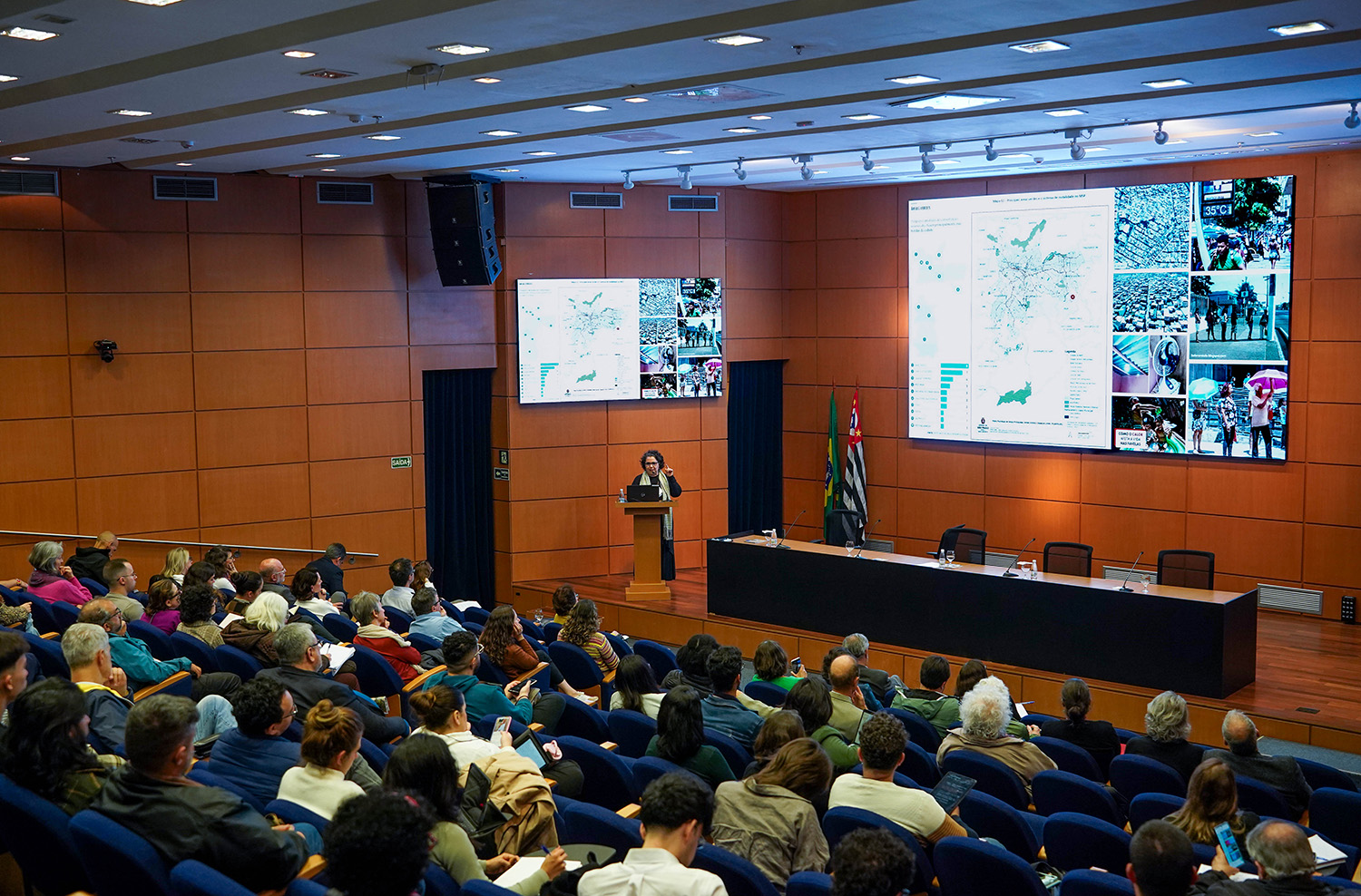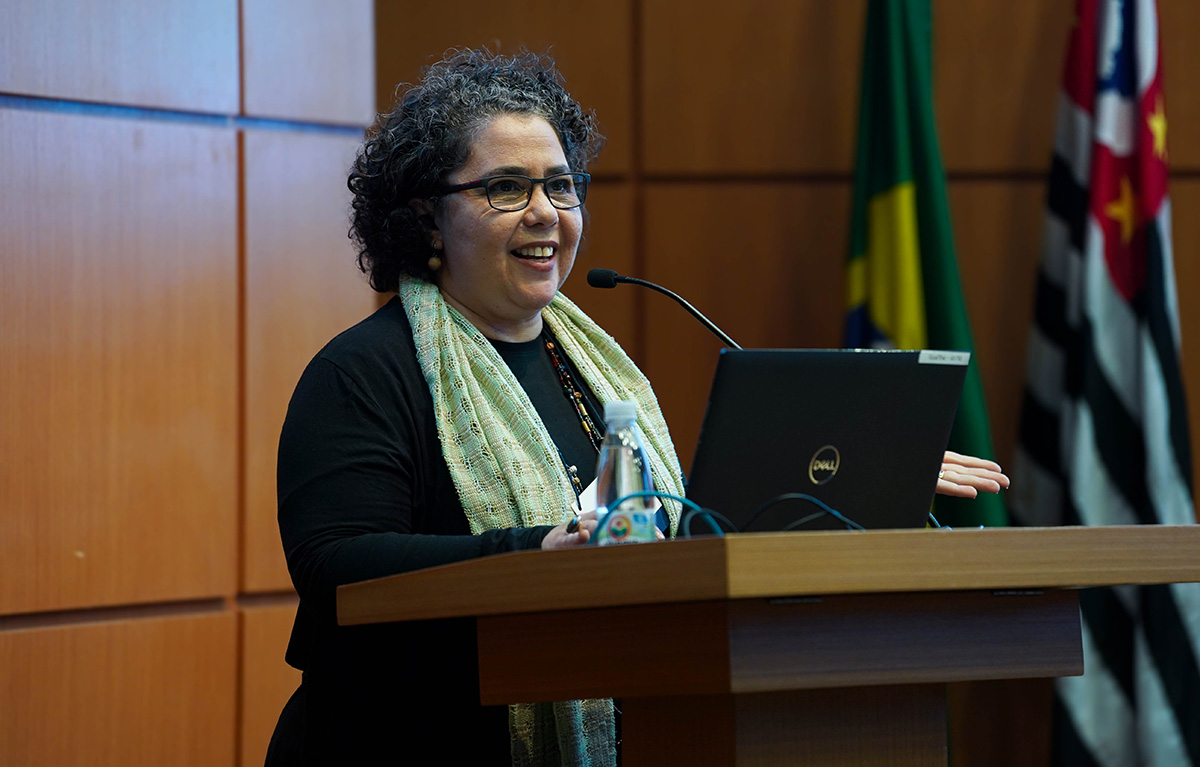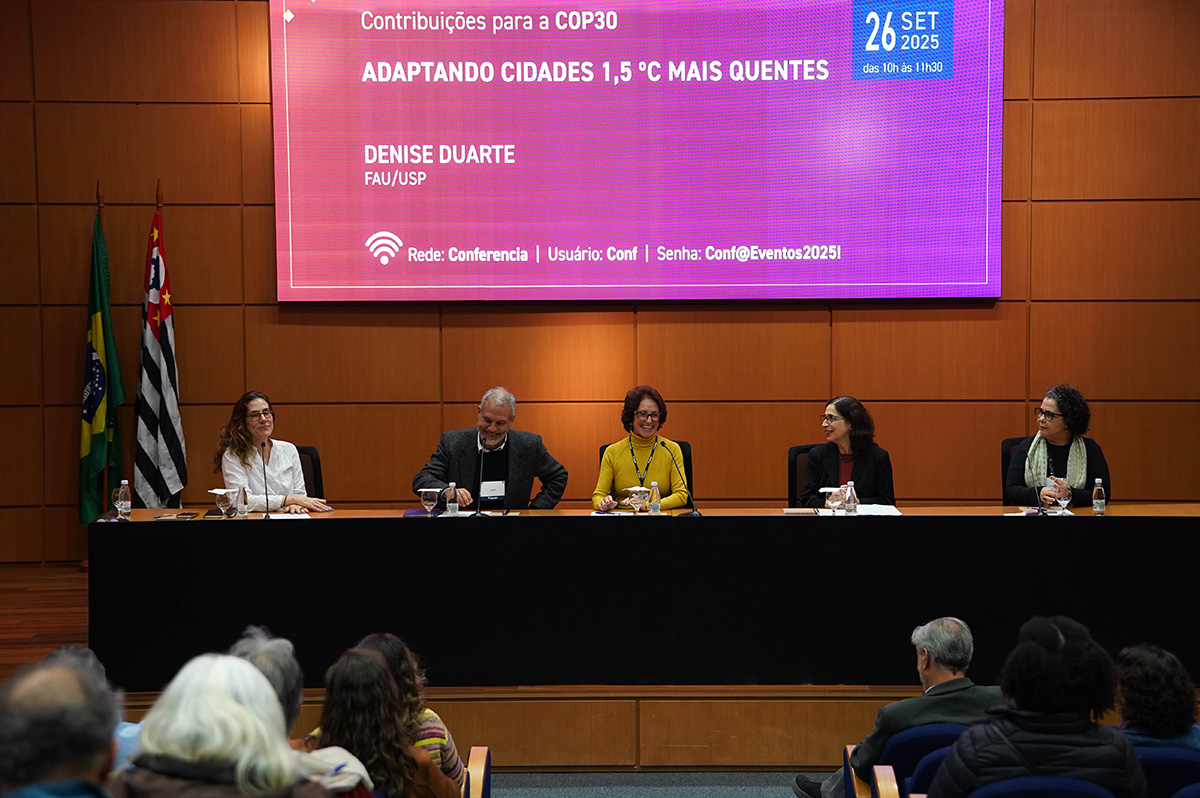

Denise Duarte pointed out that urban design and the presence or absence of green spaces, such as parks, directly affect the thermal balance of cities, and that inequality in this regard is evident in São Paulo (photo: Daniel Antônio/Agência FAPESP)
At the 7th FAPESP 2025 Conference, Denise Duarte, researcher at the University of São Paulo’s Faculty of Architecture, Urbanism, and Design, spoke about the need to map the impacts of extreme events on an individual scale and create urban thermal refuge areas in public spaces.
At the 7th FAPESP 2025 Conference, Denise Duarte, researcher at the University of São Paulo’s Faculty of Architecture, Urbanism, and Design, spoke about the need to map the impacts of extreme events on an individual scale and create urban thermal refuge areas in public spaces.

Denise Duarte pointed out that urban design and the presence or absence of green spaces, such as parks, directly affect the thermal balance of cities, and that inequality in this regard is evident in São Paulo (photo: Daniel Antônio/Agência FAPESP)
By Maria Fernanda Ziegler | Agência FAPESP – Heat waves have killed 20 times more people than rain and flooding in Brazil. However, there are still no plans in place to address this type of situation. Since heat waves leave no visible destruction, the problem is called a “silent emergency.” Nevertheless, the damage is severe. In 2024, the country experienced nine heat waves, making it the hottest year on record. This was also the first time the planet exceeded the limit of 1.5 °C above pre-industrial levels set by the Paris Agreement to avoid more dangerous consequences.
At the conference “Contributions to COP30: Adapting Cities 1.5 °C Warmer”, Professor Denise Duarte, from the University of São Paulo’s Faculty of Architecture, Urbanism, and Design (FAU-USP) emphasized the crucial role of urban areas in adapting to the new climate context.
“Adaptation needs to be where people are. Who faints? Who can’t sleep because of the heat? Where can they take refuge? We need to look at this on a people scale, and not just at open spaces, but at what happens inside homes, buildings, and during people’s daily commutes,” said Duarte, who is also the lead author of the IPCC Special Report on Climate Change and Cities (SRCities, AR7) – the chapter on climate change and cities in the United Nations (UN) Intergovernmental Panel on Climate Change report.
The group led by Duarte at USP has been studying the impact of extreme heat in São Paulo. Their most recent study mapped socioeconomic data alongside environmental factors, such as housing type, vegetation, and urban density, to identify areas of the city with the greatest thermal risk to human health. The results confirmed the hypothesis that income and housing influence the risk of heat exposure in São Paulo. Not only do low-income individuals live in homes that are more susceptible to heat, but they also work outdoors in informal jobs, making them even more exposed and vulnerable to heat waves (read more at www.sciencedirect.com/science/article/pii/S2212095525002846).
The researcher pointed out that urban design and the presence or absence of green spaces, such as parks, directly affect the thermal balance of cities. “In São Paulo, this inequality is evident. In central areas, the building density is extremely high, with around 750 people per hectare, driven by the real estate market. In the outskirts, this density reaches 1,200 people per hectare in slums, but with a more scattered and precarious urban layout,” she explained.
Therefore, on the outskirts of the city, more people live in small spaces without adequate access to transportation, shade, vegetation, or recreational areas. This lack of infrastructure exacerbates thermal discomfort and increases vulnerability to extreme heat.
In response, Duarte proposed creating a network of “urban oases” in the state capital. These oases would be public spaces adapted to provide thermal relief during heat waves using nature-based solutions and urban design strategies. “The idea is to take advantage of existing infrastructure, such as schools, sports centers, transportation terminals, and bus stops, especially along urban mobility corridors,” she explained. This proposal should be incorporated into the revision of the city’s climate plan, PlanClimaSP.
She also warned about the social impact of closing schools due to the heat. “When a school closes, children lose food, care, and supervision. Schools shouldn’t stop functioning, but become a climate refuge for the community,” she argued.

Duarte: Who faints? Who can’t sleep because of the heat? Where can they take refuge? We need to look at this on a people scale, and not just at open spaces, but at what happens inside homes, buildings, and during people’s daily commutes” (photo: Daniel Antônio/Agência FAPESP)
Urban adaptation at COP30
In her speech, Duarte interspersed excerpts from letters written by Ambassador André Corrêa do Lago, president of COP30, and addressed to the international community. She did this to contextualize the importance of the theme of urban adaptation at the conference. “The first letter proposes a global joint effort, a collective action so Brazilian and so present in architecture and urbanism. The idea is to create a platform to record and give visibility to voluntary initiatives that are already underway but need to break out of inertia and gain scale. The fourth letter presents the COP’s action agenda, focused on effectively implementing the commitments of the Global Stocktake [a component of the Paris Agreement used to monitor the implementation of agreed objectives],” she said.
The COP30 climate action agenda is structured around six axes and 30 objectives, one of which focuses on building resilience in cities, covering infrastructure and water issues. “Although this is the most direct focus for architecture and urban planning, there are several opportunities to insert the theme into other axes. Sustainable forest management, for example, can include urban vegetation, while commitments to triple renewables and double energy efficiency directly involve the construction sector, especially given the rapid pace of construction in cities such as São Paulo,” she argued.
Additionally, Duarte emphasized the fundamental role of architecture and urban planning in eradicating hunger and poverty through improvements to housing conditions, mobility, and urban infrastructure.
Mitigation
Thelma Krug, a researcher at the National Institute for Space Research (INPE) and former vice-president of the IPCC, also participated in the event. She is currently the coordinator of the Scientific Council on Climate, a technical group of 11 scientists (six of whom are Brazilian) that advises the COP30 presidency.
The scientist warned of the accelerated advance of global warming, focusing on the most traditional topic of Climate Conference negotiations: mitigation – that is, reducing greenhouse gas emissions. She noted that the planet is currently on track for a 2.8 °C average temperature increase, with regions in the Northern Hemisphere experiencing increases up to three times that amount at certain times of the year.
“Does this mean that the Paris Agreement, whose goal was to limit warming to 1.5 °C above pre-industrial levels, has failed? No. There’s been significant progress since 2015. Although we aren’t on a 1.5 °C trajectory, if we didn’t have the Paris Agreement, we’d be on a 4 °C trajectory,” said Krug.
The researcher explained that, even if we temporarily exceed the 1.5 °C limit (a phenomenon known as overshooting), it is still possible to reverse this scenario if robust strategies are adopted to remove CO₂ from the atmosphere, reforest, and fertilize the oceans. However, she warned that the greater the excess and the longer it lasts, the harder it will be to undo the damage.
Krug also expressed concern about the pace of the greenhouse gas emission reduction targets set by each country under the Paris Agreement, known as Nationally Determined Contributions (NDCs). Only seven of the G20 and BRICS+ countries submitted their new climate targets by the February 2025 deadline set by the UN. “These countries account for about 80% of global emissions. Brazil has the potential to influence this group, but it needs a fairer and more agile financing scenario,” she said.
Despite the challenges, Krug pointed out that there are already many solutions to the climate crisis – what is lacking is putting them into practice. “COP30 wants to accelerate this process with a global joint effort and parallel actions that don’t depend on the consensus of all countries. But now, it’s essential to involve banks and improve financing,” she said.

From left to right: Sabine Righetti, Victor Marquezine, Thelma Krug, Leila Vendrametto, and Denise Duarte (photo: Daniel Antônio/Agência FAPESP)
Krug announced that FAPESP was selected to join the COP30 Blue Zone, the official UN negotiation space. FAPESP will host a debate on November 15 entitled “Decarbonization by 2050: Challenges and Opportunities for South-South Cooperation.”
The seventh FAPESP 2025 Conference, “Contributions to COP30: Adapting Cities 1.5 °C Warmer,” was followed by a debate attended by Krug, Victor Marchezini from the Natural Disaster Surveillance and Early Warning Center (CEMADEN), and Leila Vendrametto from the Alana Institute. Journalist Sabine Righetti, advisor to FAPESP’s General Coordination Office – Science Media, moderated the debate.
The event can be viewed in its entirety at www.youtube.com/live/gC5uxPWu1Rg.
Republish
The Agency FAPESP licenses news via Creative Commons (CC-BY-NC-ND) so that they can be republished free of charge and in a simple way by other digital or printed vehicles. Agência FAPESP must be credited as the source of the content being republished and the name of the reporter (if any) must be attributed. Using the HMTL button below allows compliance with these rules, detailed in Digital Republishing Policy FAPESP.






